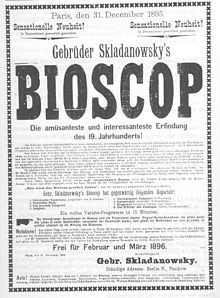Bioscope

The Bioskop (also Bioscop) was a projection apparatus of the brothers Skladanowsky used, the 54 mm film with two film loops.
Demonstrations
The first screening took place in July 1895 in the “ Feldschlößchen ” bar at Berliner Straße 27 in Berlin-Pankow and showed scenes that had previously been recorded in the restaurant's garden. The Tivoli cinema was later located in the ballroom .
On November 1, 1895 , the Skladanowsky brothers showed their films for the first time in the winter garden in Berlin following the variety program. On the same day, Max Skladanowsky was granted a patent by the Imperial Patent Office for a “device for intermittently advancing the illustrated book for photographic series”.
technology
The Skladanowsky brothers did not succeed in recording sequences of images evenly spaced. Mainly this was due to the lack of perforation on her 54mm film. They photographed scenes with their "crank case" and alternately mounted positives from the negative onto blank film. This was glued together in endless loops and then perforated by hand with rivet pliers. The bioscope is a duplex projector .
The technology was limited to playing a maximum of 24 images and did not catch on because of the above-mentioned problems.
Honor
In the course of the planning for the renovation and reopening of the Tivoli cinema on the occasion of the 100th anniversary of the Bioskop premiere, several souvenirs of the invention of the film pioneers Max and Eugen Skladanowsky were created in Berlin-Pankow. Although the Tivoli was torn down contrary to the original plans, the souvenirs have been preserved.
In front of the former site of the Feldschlößchen and Tivoli at Berliner Straße 27, there is now a mosaic strip on the footpath with the inscription "1895 BIOSKOP 1995". The first films in the bioscope are shown in oversize as film strips on the walls of the buildings in Mühlenstrasse 12 and 15. At the corner of Schönhauser Allee-Kastanienallee in the Prenzlauer Berg district there is another mosaic strip with the inscription "SKLADANOWSKY". As early as 1892 the Skladanowsky brothers were standing nearby on the roof of the house at Schönhauser Allee 146 and tried to make film recordings of the area with their self-made apparatus.
Trivia
In the former Yugoslavia and the Netherlands (bioscoop), “Bioskop” has become the standard name for the word cinema.
See also
Web links
literature
- Joachim Castan: Max Skladanowsky or the beginning of German film history . Füsslin, Stuttgart 1995, ISBN 3-9803451-3-0 , p. 63-71 .
Individual evidence
- ↑ Both spellings are used in the sources. In addition to the advertising poster shown above, there are also some with “Bioskop”.
- ^ Joachim Castan: Max Skladanowsky or the beginning of German film history . Füsslin, Stuttgart 1995, ISBN 3-9803451-3-0 , p. 50.
- ↑ The end of a legend . In: Berliner Zeitung , April 16, 2003
- ^ Film in Pankow. viewskarten-pankow.de
- ↑ Kurbei in Schönhauser Allee 146 . In: Berliner Zeitung , April 26, 2007
- ↑ recnik.krstarica.com

